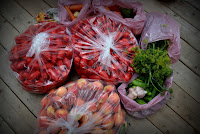From the deepest most intransigent place she came to understand her opponents and then be convinced of their opinions - and it all started when she decided to confront her enemies on twitter. So it's possible to grow out of hate.
I have to believe it. In the wake of the Paris attacks on Friday the 13th, which amplified the muted effects of the horrific bombings in Beirut, the attack on the Russian plane, I have to believe that it's possible for some to travel through hate and out the other side - if it doesn't kill them.
I've been struck by a number of things - the racism that leaks out of normal looking people when they think they've got their chance to spread hate, and the reaction of people now who won't stand for it, who will marshall their energies to help fund the rebuilding of a burned down mosque in Peterborough, who will march in protest of a violent attack on a Muslim woman in a Toronto neighbourhood, who will start an online social media hashtag pledging to support any Muslim transit riders who feel threatened - and who keep their wits about them as we face the biggest refugee crisis since the second world war. Of course we'll take them in. Of course we must. If we don't, then I don't know who we are anymore.
Also, I heard historian Margaret McMillan make an important point on CBC Radio yesterday. When a political leader 'declares war' on these people, he or she is giving them the legitimacy of a state. "These are criminals," she said. By 'declaring war', it gives them power.
And, as usual, in my experience with the more horrible side of our humanity - there is the good. The people who offered their houses to strangers on Friday night in Paris, the taxi drivers who turned off the meters to offer free rides home, the people who jumped on others to protect them from the crazed bullets. As Trevor Noah put it so beautifully the other night on The Daily Show, "Our prayers will be with Paris. Our prayers will be with the people. But let's not forget before we fight, to love."
Two weeks ago I made French Onion Soup - and yes it was for the first time. Not only making it, but actually eating it. Do not ask me how I made it past the half century mark, with a chunk of that time spent in Quebec, avoiding this culinary version of a fleecy blanket. It was a bitter November day - raining like global warming was coming with vengeance in its heart. So it was perfect. Last week, I mentioned it to my friends on Facebook and promised the recipe...and so, now when food can comfort so many, I am posting about onion soup. The French kind. I am, after all, one sixteenth French. Okay the only thing thinner than that blood, would be beef stock. Of which there's plenty here.
C'était delicieuse. Oh, and...Je suis humain.
French Onion Soup - from the clever cusses at Epicurious
5 tbsp unsalted butter, divided
3 lbs medium sized vidalia onions, halved lengthwise, peeled and thinly sliced
1 tbsp vegetable oil
1 tsp kosher salt
1/2 tsp freshly ground pepper
1/2 tsp sugar
1 1/2 cups dry white wine
6 cups beef broth*
10 sprigs thyme
2 bay leaves
1 baguette
1 garlic clove, cut in half lengthwise
2 tsp sherry, which I did not have, so I used Madeira wine
4 oz Gruyère cheese, grated
*My dear vegetarians, you could use vegetable broth, just make sure you really cook those onions down to a deep caramelized colour - that's where you'll pull the most flavour.
Serves 4. Recipe calls for 4 - 16 oz oven-safe ramekins - I have 12 oz ones which were plenty big enough and gave us leftovers.
In your large Dutch oven, melt 3 tbsp of the butter over medium heat. Add the oil and the onions, and cook about 15 minutes, or until softened. Then add the salt, pepper and sugar and continue cooking until deep, deep golden brown. Stir occasionally. This should take about 40-45 minutes. Turn down the heat if you're getting scorched onions instead of caramelized onions. Be patient. (Biggest lesson I always have to remind myself of in cooking - patience.)
Once you've got good colour (this will be where the flavour is), add the wine and increase the heat cooking until all the liquid has evaporated.
Tie the thyme and bay leaves with string in a bundle and add to the pot along with the beef broth. Bring to a boil, then reduce to a simmer for 20 to 30 minutes. Remove from heat and whisk in the remaining 2 tbsp of butter.
Turn on the broiler. Cut two slices of baguette per ramekin. Place on a rimmed baking sheet and place in oven until crispy, not brown - just over a minute. When they're done rub one side of the bread with the garlic and set aside.
Put the ramekins on the baking sheet. Add a 1/2 tsp of sherry, or Madeira, to the bottom of the bowls. Carefully ladle in the onion soup. Add two slices of baguette and top the bread with the grated cheese. Carefully put under the broiler until melted (which only took a couple of minutes for me, although the recipe says for 4-8 minutes).
The soup can be made up to 3 days ahead. Or it can freeze for six months. It was also delicious the next night.
Because. Parce que...Paris.
photo credit: http://greatermalaysia.com/2015/11/14/she-made-a-distasteful-comment-on-the-paris-attacks-his-response-deserves-a-standing-ovation/










































